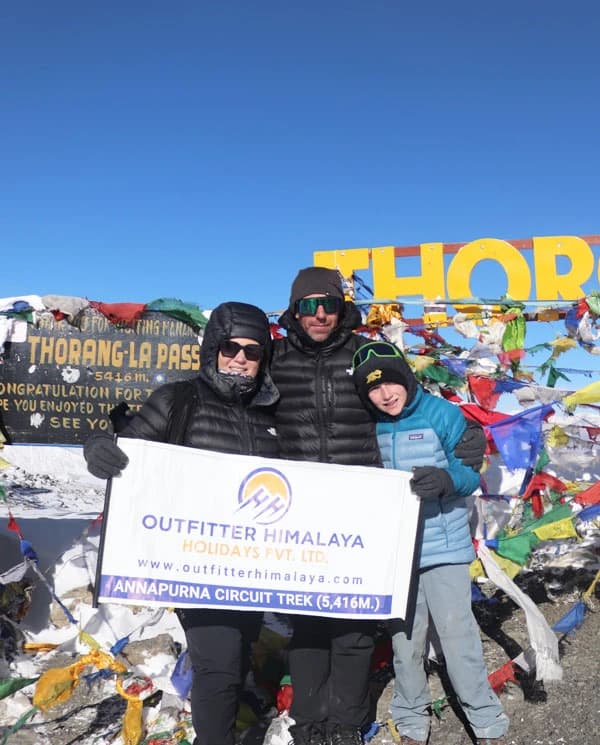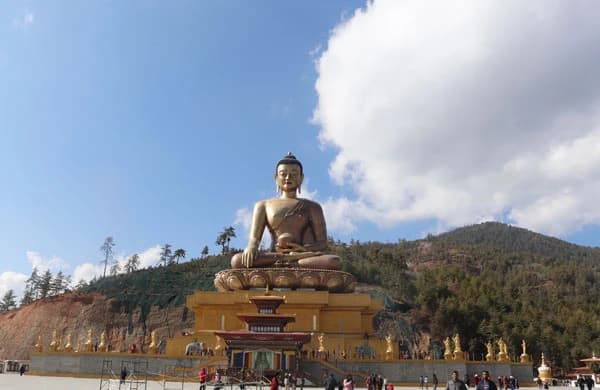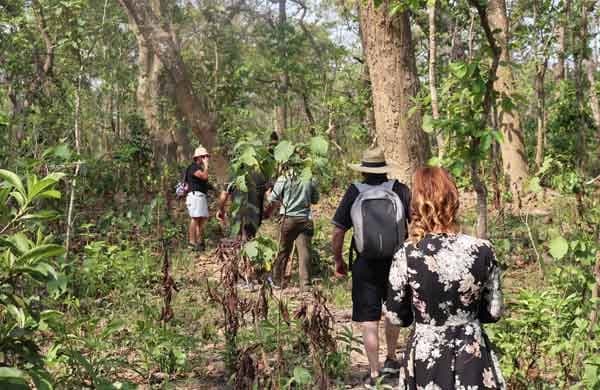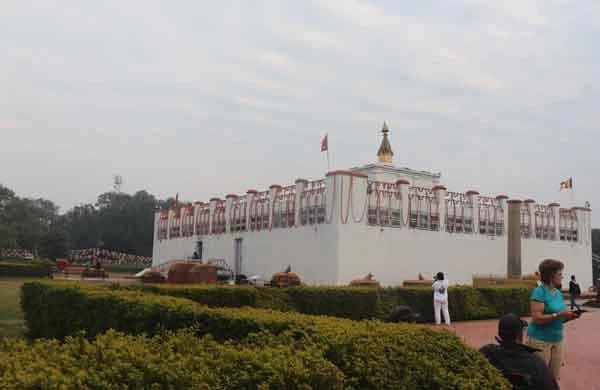Introduction to the 15 - Day Annapurna Circuit Trek
Annapurna Circuit is called the world’s best circuit trek, which truly lives up to the hype. Annapurna Round Trekking begins in lush lowlands and proceeds to Thorong La Pass (5,416m), one of the biggest trekking passes on Earth. Along the way, you will pass through charming villages, dense rhododendron forests, open meadows, and river-carved valleys, all wrapped in stunning Himalayan views of the Annapurna Himalaya.
What sets the Annapurna Circuit trek apart from other hiking adventures isn't just the scenery and the culture; challenge and discovery are all wrapped together. You will spend time in Manang village (3,519m) and enjoy short excursions to explore Braga Monastery, Parken Gompa, or even the stunning Ice Lake (4,500m). And for extra adventure, side trips to Tilicho Lake or far-off Nar Phu Valley bring even greater depth to your Nepal Annapurna Thorong La Pass Trek.
Now, the path descends from there and leads to a sacred pilgrimage site-Muktinath temple (3800m), and then into the stunning Kali Gandaki Gorge, one of the deepest in the world. If you stop in Tatopani, a dip into the natural hot springs is absolute heaven before the last push to Ghorepani. Make sure to wake early to enjoy the magic of the sunrise from Poon Hill to have a fantastic end to your Annapurna Round Trek before descending to Pokhara.
In all, the 15-day Annapurna Circuit is a full Himalayan experience. From the warmth of local hospitality to huge bowls of Daal Bhat and your guide’s stories of snow-capped adventures, this journey will stay with you long after you are home. It is a trek for adventurers who want a little dust on their shoes, a little challenge, and lovely connections.
Trek Highlights - Annapurna Circuit 15 Days
- On the Annapurna Circuit trek, follow a quiet but adventurous trail to reach the iconic Thorong La Pass (5,416m).
- Trek in the Annapurna Conservation Area, teeming with vegetation, wildlife, and changing landscapes.
- Discover Nepal's cultural diversity with Gurung, Magar, and Thakali communities during your Circuit Annapurna trekking experience.
- Stay overnight in quaint mountain villages along the Annapurna Circuit trail, each with its own culture and surreal views.
- On this Annapurna high-altitude trek, experience stunning landscapes, from verdant forests to alpine meadows.
- Throughout the Annapurna Circuit trekking journey, you will experience diverse landscapes, from verdant forests to alpine meadows and beautiful mountain views that grow visually.
- During your Annapurna Circuit trek, enjoy waterfalls, whitewater rivers, and prayer flags fluttering in the breeze at high mountains.
- Acclimatize at Manang village and explore local lakes, monasteries, and hilltop hikes on this well-paced Annapurna Circuit itinerary.
- Cross the challenging but rewarding Thorong La Pass, the high point of the Annapurna Circuit adventure!
- Get blessed at Muktinath Temple, a holy site for Hindus and Buddhists.
- Drive along the scenic Kali Gandaki Gorge with breathtaking views of Tatopani.
- Relax your weary muscles in the natural hot springs in Tatopani.
- Hike to Ghorepani and witness the spectacular sunrise over the Himalayas from Poon Hill to end your Annapurna adventure Pass trek.
Attraction and Experiences on Annapurna Circuit Trek - 15 Days
Ready to circle one of the world’s most stunning mountain ranges in Annapurna Circuit Trek? This adventure has something new around every turn.
Explore the tenth-highest mountain and a biodiversity hotspot
15 The Annapurna Circuit trek takes you far into the core of the Annapurna range, where the towering peaks of Annapurna South and Annapurna IV begin to unveil themselves on the initial days of the trek, peering out from behind hills and forests like familiar friends. As you gain altitude along this classic Annapurna Circuit trek, the path opens up, and more Himalayan giants emerge on the horizon, providing an ever-changing vista of snow-capped beauty.
This entire experience is within the Annapurna Conservation Area, Nepal's most significant protected region. The route winds through a canopy cover of rhododendrons, bamboo, oak, pine, and fir, which is a refuge for all kinds of wildlife and birdlife. Don't be surprised if you get glimpses of colorful birds scurrying across your trails in Annapurna Circuit or if you get a glimpse of shy mountain animals here and there along the way, as this trek is as much for nature as for mountains.
Follow an adventurous trekking route through the heart of the Himalayas
The Annapurna Circuit trekking is more than an adventure. The trail is filled with lush forest, narrow mountain trails, grassy meadows, and deep gorgeous gorges, keeping every step different and exciting. You will walk alongside rushing rivers and see waterfalls that make you forget the sore muscles and tiredness.
With steep climbs, rocky descents, and plenty of ups and downs, this trail pushes you to your limits while immersing you in nature's serenity and pure beauty. With every challenge in Annapurna Circuit trails comes comfort, and with every step, you are led further into the heart of the Himalayas.
Cozy villages and the friendliest faces on the trail
Annapurna Circuit takes you through several lovely villages of different ethnic communities. You come across Brahmins, Newars, and Chhetris in the lower zone. The upper trail is made up of people from the Magar, Gurung, and Thakali communities. Their warm hospitality and humble disposition will tug at your heart.
Annapurna Circuit trekking is a cultural awakening that allows you to experience another side of life. Your overnight stopovers are in the villages of Bhulbhule, Chamje, Dharapani, Pisang, Manang, Yak Kharka, Thorong Phedi, Muktinath, Tatopani, and Ghorepani. You will feel welcomed while sleeping with other trekkers in the lodges in these villages.
Side hikes in Manang: Acclimatize with a view
Trekking the Annapurna Circuit trail includes one rest day at Manang (3,519m) to acclimatize to the high altitude. This day also includes a rewarding side hike to keep you moving and soak up more mountain magic.
You have two great choices: hike to historic Braga Monastery along the scenic trail or, if you are adventurous, try the more challenging route to stunning Ice Lake (4,500m). Either way, you will gain gradual elevation as you enjoy fabulous views while soaking up Manang's alpine scenery.
Diverse landscapes and stunning mountain panorama
Annapurna Circuit Trek odyssey is a beauty to behold, as every day brings new scenery. From luscious green hills and terraced farms to rocky cliffs, alpine meadows, and barren trans-Himalayan terrain, all these landscapes change dramatically depending on the altitude gain.
And the mountains? They are just unforgettable. Along the Annapurna Circuit trekking route, you are rewarded with a sweeping panorama of Himalayan giants such as Annapurna I (8,091m), Dhaulagiri (8,167m), Nilgiri, Tilicho Peak, Fishtail, Gangapurna, and many more. Whether you are crossing a river gorge or climbing toward a high pass, the panoramas never stop coming your way, and that is the beauty of the Annapurna Circuit trail.
Walk through lush pastures and cross Thorong La Pass
The trail of Annapurna Circuit opens up into expansive alpine meadows where you find yaks and mules peacefully grazing under the Himalayan sun.
Then, the path becomes increasingly steep and rugged, leading you to the great Thorong La Pass (5,416 m), which is Nepal’s highest mountain Pass and the apex of your Annapurna Circuit adventure. To cross the pass, you will need good stamina, proper acclimatization, and the guidance of an experienced trekking staff to help you on the high-altitude trek conditions to navigate the terrain.
As a dreamy bonus to the already beautiful Annapurna Circuit Trek, you will stand atop Thorong La Pass, and feel absolutely priceless once you conquer it.
Receive blessings at the sacred Muktinath Temple
After crossing Thorong La Pass, the trek brings you to Muktinath Temple (3,800m), a deeply spiritual place and a religious stop on the Annapurna Circuit Route. Sacred to both Hindus and Buddhists, the 7th-century temple is among the 108 sacred Siddhpeeth. Surrounded by a peaceful mountain landscape and fluttering prayer flags, Muktinath is a serene spot to meditate, rest, and receive blessings before continuing your journey along the Kali Gandaki Valley.
Travel along the world’s deepest gorge and pass by stone houses
As soon as you depart from Muktinath, the Annapurna Circuit Journey continues along the Kali Gandaki Gorge, the deepest gorge in the world, formed between the Annapurna and Dhaulagiri mountains. Although less often referred to, the ancient trade route you will follow once connected Tibet, Nepal, and India.
Soak in the natural hot springs of Tatopani
A pleasant relief after days of trekking in Annapurna Circuit, Tatopani is a great place to unwind. Renowned for its natural hot springs, this small village offers a warm respite on the descent. The springs request a small entry fee, managed by the locals, but they're worth it.
A relaxing dip here rejuvenates fatigued muscles and is rumored to be curative for skin conditions. Be sure to wear a swimsuit and have some extra cash for this water-healing pleasure!
Catch a magical sunrise from Poon Hill
Towards the end of the Annapurna Circuit Hike, you will climb to Poon Hill (3,210m), a favorite viewpoint above the village of Ghorepani. It is an early morning walk to catch the magical panoramic sunrise lighting up the Annapurna and Dhaulagiri ranges in gold and pink hues.
Poon Hill is a highlight on its own, often undertaken as a short trek, but as part of the full Annapurna Circuit, it is the perfect finish to your Himalayas adventure in Nepal.
Annapurna Circuit Trek - 15 Days Itinerary
Annapurna Circuit Trek's 15-day itinerary is an incredible adventure filled with mountain highs, cultural gems, and joyful trails. From Kathmandu's temples to Dharapani's trailhead, your path winds its way through Chame, Pisang, and the spiritual Manang village. After acclimatization at Manang, you climb higher again to Yak Kharka and Thorong Phedi, preparing yourself for the great Thorong La Pass at 5,416m.
Then, it is a drive up to the sacred stop of Muktinath, a scenic tour to Tatopani, and a steep ascent to Ghorepani. A sunrise morning hike up to Poon Hill lights up the Himalayas before you unwind in Ulleri. Once you depart from Ulleri, you will be left with some relaxation time in Pokhara and a warm farewell in Kathmandu; look at the detailed day-to-day itinerary section of the page for daily details.
Annapurna Circuit Trek Options with Outfitter Himalaya
The Annapurna Circuit Trek is 15 days package that goes Thorong La Pass, however, We have some other alternative Itinerary to complete the Annapurna Circuit trail, and some of them are Short Annapurna Circuit Trek, Tilicho Lake Trek with Annapurna Circuit, Nar Phu with Annapurna Circuit and Annapurna Circuit with ABC.
Annapurna Circuit Trek Altitude: How High is Annapurna Circuit?
Annapurna Circuit Trek is a roller coaster of altitudes, from the green lowlands of Besisahar at just 760 meters to the stunning Thorong La Pass height of 5,416 meters!
Gradually, en route, you ascend through charming villages like Chame and Pisang, then up to 3,450 meters in Manang, where you will rest to get your breath back and acclimatize. Then, up and away to Yak Kharka and ThorongPhedi, your gateway to passing through Nepal's renowned highest mountain pass. After the arduous ascent, you descend to the sacred village of Muktinath at 3,800 meters, then down again to the warm valley of Tatopani (1,190 meters) - yes, that's nearly 4,300 meters of elevation gain!
The hike ends with a forest climb to Ghorepani (2,860m) and a magical sunrise at Poon Hill (3,210m). With each shift in elevation, the landscape, culture, and adventure shift - each step along the Annapurna Circuit is a new world. Look at the attached Annapurna Circuit Trekking route map to learn about daily altitude gain.
Annapurna Circuit Trek Length: How long is Annapurna Circuit?
In our 15-day Annapurna Circuit Trek Itinerary, you will cover around 116 kilometers on foot, starting from Dharapani (1,960m) and ending at Ulleri (2,070m). Along the way, you will pass through beautiful villages like Chame, Pisang, and Manang before reaching the iconic Thorong La Pass at 5,416m,the highest point of the adventure. Look at the detailed Itinerary section for daily walking distance.
Annapurna Circuit Trek Route Map
The 15-day Annapurna Circuit Trek will start in Dharapani and lead you through Chame, Pisang, and Manang before crossing the famous Thorong La Pass at 5,416m. The trek then moves down towards the holy site of Muktinath, from which it traverses pathways to Tatopani and Ghorepani, with an ascent to Poon Hill for sunrise.
Along the trails, you can find diverse terrains, pretty villages, and breathtaking views of the Himalayas. Check our route map on the page for more details.
Annapurna Circuit Trek Cost and Booking for 2026 and 2027
We have fixed the Cost for the Annapurna Circuit Trek for 2026 and 2027. The cost varies depending on the number of people traveling. Find the details of the cost below. We have also fixed the departure date for the Annapurna Circuit small group Trek. Find the list of dates below and book your suitable date. If these dates are not suitable or if you want to have a private trek, check availability to book the Trek on your own date.
Annapurna Circuit Trek Cost
| Number of trekkers |
Cost in USD, per person |
| 1 Pax |
1100.00 |
| 2-5 Pax |
950.00 |
| 6-8 Pax |
900.00 |
| 8 -12 Pax |
800.00 |
| 13 and above pax |
Inquire |















